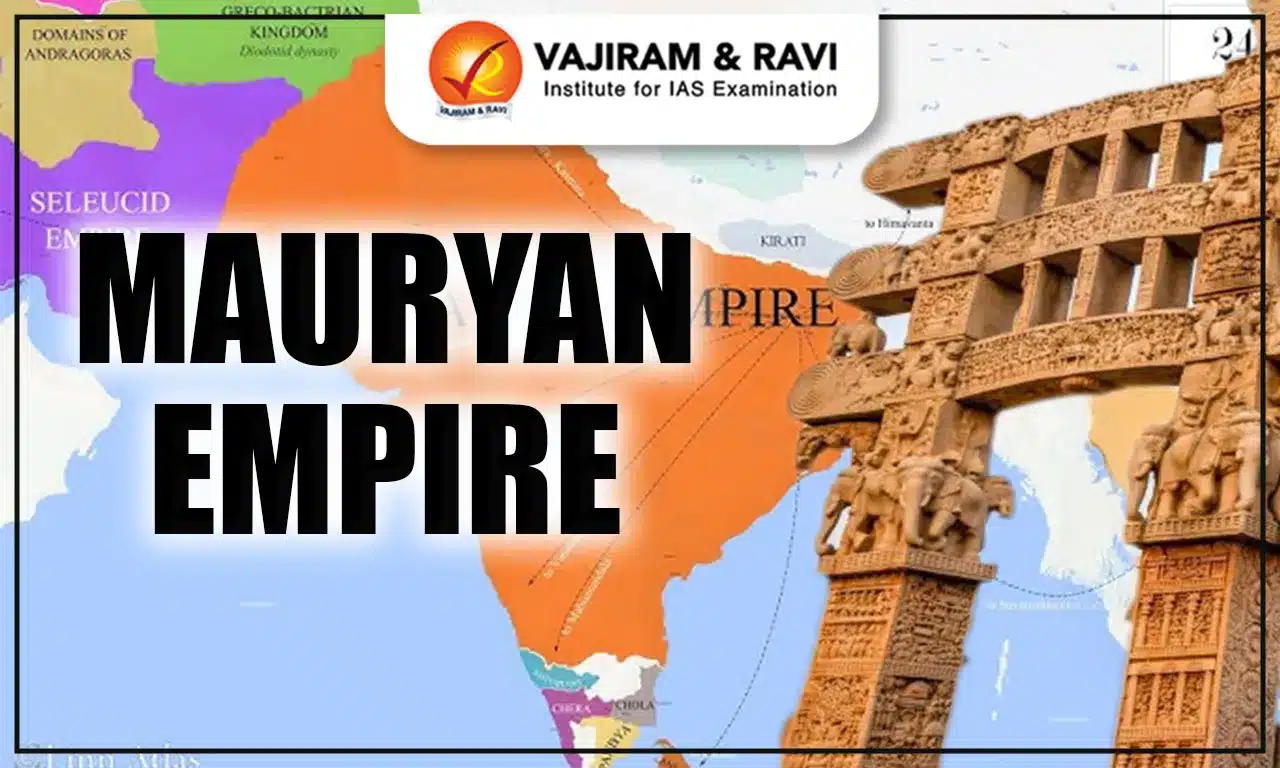Chandragupta Maurya (321–297 BCE) is considered to be the founder of the Mauryan Empire. Inspired by Alexander, Chandragupta built up an army and overthrew the Nanda power in Magadha, in present-day eastern India, establishing the Mauryan Empire. After becoming king, Chandragupta took additional lands by force and alliances. Chandragupta’s chief minister, Kautilya, sometimes advised Chandragupta and contributed to the empire’s legacy.
The Mauryan empire marks a watershed juncture in Indian history. For the first time in India's history, a large portion of the subcontinent, extending up to the far northwest, was ruled by a single supreme power.
Sources for the Mauryan Period
- Kautilya’s Arthashastra
- Ashokan inscriptions
- The most important literary source is Megasthenes’ Indica.
- Divyavadana and the Ashokavadana
- Sri Lankan Buddhist chronicles included the Mahavamsa, theDipavamsa, and the kings listed in Puranas.
- Bulandi Bagh and Kumrahar archaeological remains are associated with the Mauryan capital, Pataliputra.
Mauryan Empire Rulers and their Contributions
Archaeologically, the Mauryan period in South Asia corresponds to the Northern Black Polished Ware (NBPW) era.
| Period: 321 BCE- 185 BCE | Capital: Patliputra |
|
Chandragupta Maurya (321 BCE-297 BCE) |
- Parishishtaparvan, written by Hemachandra, identifies Chandragupta as the grandson of the chief of the peacock tamers clan (mayura-poshakas). - He was the chief architect of the Mauryan empire and built a vast empire, which included Bihar, Nepal, western and north-western India, and the Deccan. - War with Seleucus: The Mauryans annexed several areas in the Hindu Kush region in 305 BC. These regions were governed by satraps (governors) appointed by Alexander during his campaign.
- Treaty with Seleucus Nicator (303 BCE): According to the terms of this treaty, Seleucus ceded Chandragupta the territories of Arachosia (the Kandahar area of south-east Afghanistan), Gedrosia (south Baluchistan), and Paropomisadai (area between Afghanistan and the Indian subcontinent).
- Greek historians Megasthenes and Dionysius resided at the Mauryan court. - Religion: Chandragupta gave up his throne and became a disciple of Jain teacher Bhadrabahu. |
| Bindusara (297 BCE-273 BCE) |
- The Mahabhashya refers to Chandragupta’s successor as Amitraghata (a slayer of enemies).
- Conquest: He brought sixteen states under the Mauryan Empire and thus conquered almost all of the Indian peninsula.
- Deimachus was the Seleucid emperor Antiochus I's ambassador at Bindusara's court. - Religion: He joined the Ajivika sect. |
| Ashoka (272 BCE –232 BCE) |
- During his father’s reign, he was appointed as the Viceroy of Taxila and Ujjain. - He was the first ruler to maintain direct contact with his people through his inscriptions. - Names of Ashoka: Buddhashakya and Ashoka (in the Maski Edict), Dharmasoka (Sarnath inscription), Devanampiya (meaning beloved of the gods), and Piyadassi (given in the Sri Lankan Buddhist chronicles Dipavamsa and Mahavamsa). - Kalinga War: Fought between Ashoka and the state of Kalinga.
- Religion: Proponent of Buddhism; Organised 3rd Buddhist Council at Pataliputra. - Dhamma: The word ‘Dhamma’ is the Prakrit form of the Sanskrit word ‘Dharma’.
|
|
Dasharatha (232 BCE - 224 BCE) |
- He was the last ruler of the Mauryan dynasty to have issued imperial inscriptions. - Several territories of the empire broke away during his reign. - Religion: Continued the religious and social practices of Ashoka. |
|
Samprati (224 BCE - 215 BCE) |
- Samprati ruled both from Pataliputra and Ujjain, according to the Jain text Parisistaparvan. - He reconquered the provinces of Saurashtra, Maharashtra, Andhra, and Mysore, which were disintegrated after Ashoka’s death. - Contributions to Jainism: He is regarded for his patronage and efforts to spread Jainism in East India.
|
|
Shalishuka (215 BCE - 202 BCE) |
- He was mentioned in the Gargi Samhita's Yuga Purana section as a quarrelsome, unrighteous ruler. |
|
Devavarman (202 BCE- 195 BCE) |
- According to the Puranas, he was Shalishuka's successor and reigned for seven years. |
|
Shatadhanvan (195 BCE - 187 BCE) |
- According to Puranas, Shatadhanvan succeeded Devavarman Maurya. - The empire lost some of its territories because of invasions from outside and neighbouring kingdoms during his reign. |
|
Brihadratha (187 BCE - 185 BCE) |
- Brihadratha was the last Mauryan emperor. - According to some sources, he was assassinated by his Brahman commander-in-chief, Pushyamitra Shunga, who went on to establish the Shunga Empire. |
Mauryan Empire Map

Mauryan Empire Society and Religion
- Megasthenes and later Greek authors describe Indian society at the time of Mauryas as being divided into seven distinct groups – philosophers, cultivators, hunters and herders, artisans and traders, overseers (spies), and the king’s counsellors.
- These occupations were hereditary, and
- Intermarriage between groups was not allowed.
- Religion: Chandragupta took recourse to Jainism in his later years, and Bindusara favoured the Ajivikas. In his personal life, Ashoka practised Buddhism, but he never imposed it on his subjects.
Agrarian Society
The majority of the population concentrated on agriculture. All accounts speak of the profusion and diversity of crops achieved due to the profitable combination of highly fertile soil, rivers, and plentiful rainfall.
- Non-agrarian activities such as the herding of animals were practised even within villages.
- Kautilya even listed animals among the items that were assessed and taxed.
- Status of Women: Women occupied a high position and freedom and were employed as the King's personal bodyguards.
- They were permitted to divorce or remarry.
Slavery under Mauryan Empire
- According to Megasthenes, there was no concept of slavery in India.
- But some other sources mentioned situations that led to enslavement – a person could be a slave either by birth, by voluntarily selling themselves, by being captured in war, or as a result of judicial punishment. Kautilya also discussed various types of slaves.
- Ashokan Major Rock Edict V: Concerns about the policy towards slaves. He mentions in this rock edict, "Every Human is my child".
Mauryan Empire Economy
Agriculture was the leading sector during the Mauryan Empire, contributing significantly to revenue and employment. The fertile soil allowed for two crop cycles, including food grains and commercial crops like sugarcane and cotton. Crafts, such as weaving cotton fabrics, were widespread. Trade and exchange became crucial as the economy diversified and expanded beyond subsistence needs.
- Agrarian Economy: The Arthashastra recognised permanent village settlement as a method of expanding the agrarian economy. This method of settlement was known as janapadanivesa.
- Agriculture in other areas of the Mauryan State, known as janapada territories, was, in all probability, carried on privately.
- Sita or crown lands: In these areas, the King's and the State's rights to possession, cultivation, mortgage, and sale were naturally superior.
- Sitadhyaksa, or superintendent of agriculture, supervised the cultivation works here.
- Currency: During the Mauryan Empire, the primary form of currency in widespread circulation was the silver coin called the "pana" and its smaller denominations.
- Rajapanya: Goods produced by states were called rajapanya, and different categories of officials were stationed there to look after specific departments.
Mauryan Empire Land Revenue
The Mauryan era was a watershed moment in the evolution of ancient India's taxation system.
- Samaharta: Collector general of revenue for the Mauryan Empire. He had control over the expenditure part also.
- Sannidhata: Officer-in-charge of the treasury and store.
- Bhaga (land tax): 1/4th of the produce paid by the peasants.
- The peasants paid a tax known as pindakara, which was levied on groups of villages by husbandmen.
- Other taxes were Bali and Hiranaya (paid in cash).
Mauryan Empire Trade
The Jataka stories frequently mention caravan traders transporting large amounts of goods to various parts of the country.
- Trade routes: The main trade routes in northern India were along the Ganges River and the Himalayan foothills.
- Megasthenes also mentions a land route linking the North West to Pataliputra.
- It was connected to Central India in the south and Kalinga in the south-east. This eastern route turned southwards to reach Andhra and Karnataka finally.
- Taxila (near Islamabad) was the overland route to Western countries.
- Internal trade was considerably beneficial because river transport improved once the forests around the Valleys had been cleared under State initiative.
- The artisans during the Mauryan period were organised along guild lines. The well-known guilds were metallurgists, carpenters, potters, leatherworkers, painters, textile workers, etc.
- The State employed some artisans like armourers, shipbuilders, and stone builders. They were exempt from paying taxes because they performed mandatory labour services for the state. Other artisans who worked for the State were taxed, like spinners, weavers, miners, etc.
- The State's policy, particularly under Bindusara and Ashoka, of maintaining peaceful and friendly relations with the Greeks boosted foreign trade.
- Key officers:
- Panyadhyaksha: Superintendent of commerce whose duty was to fix prices of goods.
- Samsthadhyaksa: Look after the markets and check the unfair practices of the traders.
- Pautavadbyaksa: Superintendent of weights and measures.
- Navadhyaksha: Facilitated state boats for transport and helped regulate river transport and collect ferry charges.
- Sulkadhyaksa: Superintendent of tolls.
- Akaradhyaksa: Superintendent of mines.
Mauryan Empire Decline
The imperial authority of the Mauryas began to weaken with the death of Ashoka (232 BCE) and finally collapsed in 180 BCE. The major reasons for its decline are:
- Successors of Ashoka:
- After Ashoka, the empire fragmented, and there was a quick succession of rulers. This weakened the imperial control over the administration.
- These rulers ruled only for a short period and, therefore, could not formulate either new governance policies or maintain the old ones.
- Other Political factors for disintegration:
- Dhamma-mahamattas (large body of officials of State) might have become very powerful and oppressive during the latter half of Ashoka’s reign.
- Weak rulers for a short duration resulted in an overwhelming number of new officials constantly emerging and owing only personal loyalty to their respective kings rather than to the State.
- The complex system of spies under the later Mauryas collapsed, which led to corruption.
- Economic factors:
- The state monopoly on metals was gradually eroding. Magadha could no longer meet the increasing demand for iron, which was critical to the expanding agrarian economy.
- Expansion in cultivation, extensive use of forest wood, and deforestation, in general, may have led to floods and famines. There is, in fact, evidence of a big famine in north Bengal during the Mauryan period.
- In a centralised administrative system, the problem of not having enough revenues created many other acute difficulties. To enhance the revenues, the Arthashastra suggested that taxes should be imposed even on actors, prostitutes, and so on.
Last updated on November, 2025
→ Check out the latest UPSC Syllabus 2026 here.
→ Join Vajiram & Ravi’s Interview Guidance Programme for expert help to crack your final UPSC stage.
→ UPSC Mains Result 2025 is now out.
→ UPSC Notification 2026 is scheduled to be released on January 14, 2026.
→ UPSC Calendar 2026 is released on 15th May, 2025.
→ The UPSC Vacancy 2025 were released 1129, out of which 979 were for UPSC CSE and remaining 150 are for UPSC IFoS.
→ UPSC Prelims 2026 will be conducted on 24th May, 2026 & UPSC Mains 2026 will be conducted on 21st August 2026.
→ The UPSC Selection Process is of 3 stages-Prelims, Mains and Interview.
→ UPSC Result 2024 is released with latest UPSC Marksheet 2024. Check Now!
→ UPSC Prelims Result 2025 is out now for the CSE held on 25 May 2025.
→ UPSC Toppers List 2024 is released now. Shakti Dubey is UPSC AIR 1 2024 Topper.
→ UPSC Prelims Question Paper 2025 and Unofficial Prelims Answer Key 2025 are available now.
→ UPSC Mains Question Paper 2025 is out for Essay, GS 1, 2, 3 & GS 4.
→ UPSC Mains Indian Language Question Paper 2025 is now out.
→ UPSC Mains Optional Question Paper 2025 is now out.
→ Also check Best IAS Coaching in Delhi
Tags: mauryan empire quest

















